10 Proven Natural Ways to Reduce Excessive Hair Breakage
- Regardless of age or hair type, one of the most prevalent issues people deal with is hair breakage.
- Breakage happens when the hair shaft weakens and breaks mid-length or at the ends, as opposed to hair fall, which is when strands fall out from the root.
- This results in frizz, split ends, and a generally lifeless look in addition to affecting hair thickness.
- Reduce Excessive Hair Breakage Naturally Hair can become fragile for a number of causes, including chemical treatments, excessive heat styling, dehydration, dietary deficiencies, and even everyday routines like hard combing.
- These elements weaken the hair’s exterior layer, or cuticle, over time, making the strands more brittle and prone to breaking.
- A balanced approach is crucial since trichologists stress that strengthening hair involves both internal feeding and external maintenance.
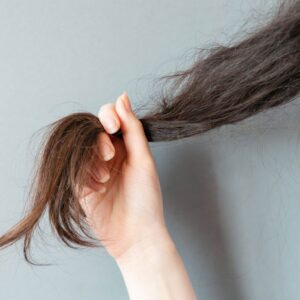
- The good news? To restore the strength of your hair, you don’t need harsh chemical products or costly salon procedures.
- There are several safe, efficient, and scientifically proven solutions in nature that can greatly lessen breakage while enhancing manageability and shine.
- The hair-nourishing properties of ingredients including coconut oil, aloe vera, hibiscus, rosemary, banana, shea butter, and onion juice have all been researched.
- These treatments produce long-lasting effects when paired with good practices including careful detangling, avoiding high heat, and consuming a diet high in nutrients.
- Ten tried-and-true natural solutions to lessen excessive hair breakage will be discussed in this blog, supported by both contemporary science and conventional wisdom.
1. Nourish with Coconut Oil
- Rich Fatty Acids That Repair Damaged Strands
- The use of coconut oil as a natural hair elixir has long been praised, and contemporary research now confirms what traditional medicine has long stressed.
- Coconut oil’s special fatty acid content, especially lauric acid, is the main factor contributing to its effectiveness.
- Because of its straight structure and low molecular weight, lauric acid can enter the hair shaft deeply rather than only coating its surface like other oils can.
- One of the very few natural oils that has been shown to lessen protein loss in both damaged and undamaged hair is coconut oil, according a study published in the Journal of Cosmetic Science.
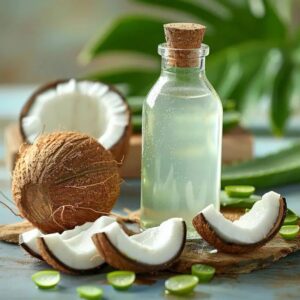
- The capacity of coconut oil to retain moisture while acting as a barrier against environmental aggressors like pollution and UV radiation is another important advantage. Coconut oil strengthens hair fibers over time and lessens their susceptibility to breaking by lowering hygral fatigue, which is the swelling and shrinking of hair caused by repetitive water absorption and drying.
- Coconut oil is frequently suggested by dermatologists and trichologists for those with dry, brittle, or chemically damaged hair. In addition to keeping the scalp healthy, its inherent antibacterial and antifungal qualities lower the chance of infections and dandruff, which can impede the growth of healthy hair.
- Best Way to Massage Coconut Oil for Strength
- Even though applying coconut oil is beneficial, how it is applied can have a significant impact. Warm coconut oil applied gently to the scalp increases blood flow to the hair follicles and enhances absorption. Stronger, healthier growth is supported by increased blood flow, which supplies the roots with vital nutrients and oxygen.
- Here is a detailed guide that hair care professionals recommend:
- Avoid warming the oil; lukewarm oil promotes better penetration without destroying nutrients.
- To ensure that the oil reaches the scalp uniformly, section your hair.
- For five to ten minutes, massage with your fingertips using tiny circular motions. This promotes follicular activity in addition to relaxing the scalp.
- Give the fatty acids enough time to strengthen the strands by leaving it overnight or for at least two to three hours.
- Choose a sulfate-free shampoo instead of a harsh one because harsh cleaners might remove the oil and its advantages.
- Oiling once or twice a week is advised by experts for optimal results because doing so every day could cause buildup and make hair seem heavier.
2. Strengthen with Aloe Vera
- Natural Enzymes That Boost Scalp Health
- Aloe vera has been utilized for ages in natural therapies and is frequently referred to as the “plant of immortality” in Ayurveda. Aloe vera is more than simply a calming gel when it comes to hair care; it is a potent combination of vitamins, minerals, and enzymes that directly promote the health of the scalp and hair.
- Proteolytic enzymes are among the most significant bioactive substances found in aloe vera. By preventing clogged follicles and fostering a clean, healthy environment for hair growth, these enzymes aid in the gentle removal of dead skin cells from the scalp. A clean scalp lowers the chance of weak or thinning hair by allowing hair follicles to work at their peak efficiency.
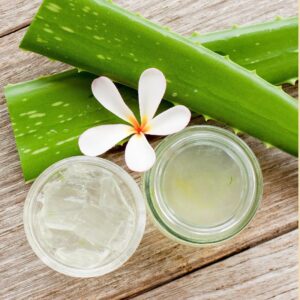
- Aloe vera also contains antibacterial and anti-inflammatory qualities that help reduce dandruff, itching, and irritation of the scalp.
- Reduce Excessive Hair Breakage Naturally Aloe vera’s natural chemicals, such as acemannan, have been shown in studies published in the Journal of Dermatological Treatment to enhance skin healing and reduce inflammation in the scalp, which makes it particularly beneficial for those with sensitive or flaky scalps.
- Vitamins A, C, and E—antioxidants that fight free radical damage—are also abundant in aloe vera.
- Aloe’s folic acid and vitamin B12 further encourage cell regeneration, keeping hair roots nourished. The natural polysaccharides in the gel aid in moisture retention, avoiding brittleness and dryness, which frequently result in breakage.
- DIY Aloe Vera Hair Mask for Smooth, Breakage-Free Hair
- Making your own hair mask is one of the finest methods to benefit from aloe vera’s strengthening properties. This makes it possible for the nutrients to deeply hydrate and mend the scalp and hair strands.
- You can attempt this easy recipe at home that has been authorized by dermatologists:
- Components:
- Two teaspoons of fresh aloe vera gel (either organic store-bought or from the leaf)
- One tablespoon of olive or coconut oil (for added nutrition)
- One teaspoon of honey (optional; adds shine and moisture)
- Approach:
- Make a smooth paste by blending all the ingredients together.
- Evenly distribute the mixture throughout the length of your hair and on your scalp.
- For five minutes, massage lightly to increase circulation.
- Give it a half-hour to an hour.
- After rinsing with lukewarm water, use a gentle shampoo without sulfates.
- This mask combines aloe vera’s scalp-healing enzymes with the moisturizing power of natural oils, resulting in smoother, shinier, and more manageable hair.
- With consistent use (once a week), you can see reduced breakage and improved hair texture.
- Because of its mild yet potent qualities, dermatologists frequently suggest aloe vera to patients who are suffering from dandruff, scalp irritation, or weak hair. When applied topically, aloe vera rarely causes negative effects and is safe for the majority of hair types, unlike harsh chemical treatments.
- However, because some people may have moderate allergic responses, doctors advise completing a patch test before applying raw aloe directly. Maximum efficacy and purity are guaranteed when the gel is freshly extracted from the leaf, but store-bought aloe gels with few additions may still be helpful.
- Aloe vera’s special combination of nutrients and enzymes offers long-term strengthening advantages in addition to instant relief from scalp problems. It is a natural, safe, and scientifically proven option for anyone looking for hair that is smooth and free of breakage.
3. Protect with Hibiscus & Rosemary
- Herbal Remedies to Reduce Brittleness
- Hibiscus and rosemary are two of the most revered herbs in both traditional and contemporary hair care, and nature provides strong hair protection options.
- Each contributes special bioactive substances that fortify the hair shaft, lessen brittleness, and shield individual strands from harm.
- Often referred to as the “flower of hair care,” hibiscus is high in vitamin C, flavonoids, and amino acids. Keratin, the protein that gives your hair its structure, is produced with the aid of amino acids, strengthening and reducing the likelihood of breakage.
- As antioxidants, flavonoids protect hair from oxidative stress brought on by pollutants and UV radiation. A natural collagen enhancer, vitamin C promotes suppleness and delays premature breakage.
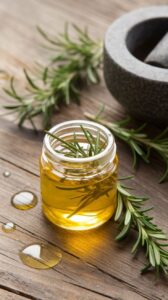
- Rosemary also improves scalp microcirculation, ensuring that hair follicles receive adequate nutrients and oxygen. Its natural antioxidant and antimicrobial properties protect the scalp from infections and free radical damage, creating a healthier environment for stronger, more resilient hair.
- Together, hibiscus and rosemary offer a protective shield for the hair—hibiscus nourishes and conditions, while rosemary stimulates and fortifies. This combination makes them a powerful natural remedy to combat brittleness and breakage.
- How to Use Hibiscus/Rosemary Oil or Rinse
- Herbal oils and rinses are two of the best ways to use hibiscus and rosemary in your routine, though there are other methods as well.
- Use of Hibiscus/Rosemary Oil:
- Two to three teaspoons of oil infused with hibiscus or rosemary (or a combination of the two) should be warmed.
- For ten minutes, divide your hair into sections and gently massage the oil into your scalp.
- Coat the strands of your hair with the leftover oil by applying it along its length.
- Let it sit for at least one or two hours, or overnight.
- Use a gentle shampoo to wash.
- After washing, use a herbal rinse:
- For ten to fifteen minutes, bring two cups of water to a boil and add a handful of hibiscus flowers or two tablespoons of dried rosemary leaves.
- After allowing the mixture to cool, filter it.
- After shampooing, give yourself a last rinse with the herbal water.
- Let your hair air dry naturally instead of washing it out.
- While the rinse adds luster, softness, and protection against brittleness, the oil provides deep nourishment and strength. Hair texture and resilience can be greatly enhanced by frequent application, at least once per week.
- Herbal therapies are gentle and effective, but consistency is crucial, according to trichologists.
- Although it could take a few weeks of consistent use for natural herbs to produce noticeable effects, their long-term advantages are safe and durable, unlike artificial treatments.
- Experts also point out that in order to prevent irritation of the scalp, rosemary oil should always be diluted with a carrier oil before use.
- Similarly, using hibiscus sparingly avoids any mess because it can occasionally create mild stains.
- In the fight against brittle, fragile hair, hibiscus and rosemary are reliable herbal friends because of their established history in traditional medicine and increasing scientific support.
- Including them in your hair care regimen naturally rejuvenates and protects your hair.
4. Hydrate with Banana Hair Mask
- Potassium and Natural Moisture for Elasticity
- A banana is a natural superfood for your hair in addition to being a nutrient-dense fruit. Rich in potassium, natural sugars, vitamins, and antioxidants, bananas increase elasticity and deeply hydrate hair, leaving it smoother, softer, and less likely to break.
- Because it contributes to the structural integrity of hair, potassium is particularly significant. Weakened hair strands and dryness can result from low potassium levels. The potassium in bananas helps to strengthen hair fibers when applied topically, restoring elasticity and lowering the chance of their breaking under stress (such as when brushing or styling).
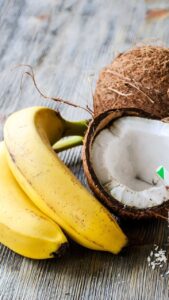
- In addition, bananas are a great source of vitamin B6, vitamin C, and silica, all of which help to build collagen. In order for hair strands to remain elastic and flex rather than break, collagen is essential. The natural sugars in the fruit work as humectants, drawing and retaining moisture in the hair shaft, making them ideal for treating frizz and dryness.
- Natural humectants, such as those found in bananas and honey, enhance hair’s ability to retain water, which results in more softness and shine, according to scientific research in cosmetic science. For those with dry, curly, or heat-damaged hair, banana masks are especially helpful since they restore hydration and increase suppleness.
- Simple Banana + Honey Mask Recipe
- Making a hair mask at home using bananas is simple and efficient. Since honey is a natural humectant that draws moisture from the surrounding air into your hair, it improves hydration when coupled with banana. When combined, they provide a potent remedy for brittle, dry, or dull hair.
- Components:
- One ripe banana (the softer and easier to blend the riper the banana).
- One tablespoon of unprocessed honey
- One tablespoon of coconut or olive oil (optional, for extra nutrition)
- Approach:
- Blend the banana into a smooth puree or mash it well until there are no lumps.
- Stir in oil and honey until completely blended.
- From the scalp to the ends of your hair, evenly apply the mask.
- To improve absorption and stop leakage, cover with a shower cap.
- For those who suffer from environmental damage, frizz, or chronic dryness, hair professionals frequently suggest fruit-based masks like bananas. Bananas function by supplying nutrients straight to the hair shaft, in contrast to artificial conditioners that might only temporarily smooth hair.
- To prevent greasiness, trichologists advise those with oily scalps to apply the mask mostly to the mid-lengths and ends. Always rinse well and then use a gentle shampoo to get rid of any residue for optimal results.
- The banana hair mask uses the power of natural potassium and moisture and is a safe, reasonably priced, and scientifically proven home cure. Without using artificial treatments, you can get moisturized, elastic, and breakage-resistant hair by incorporating it into your routine.
5. Moisturize with Shea Butter or Avocado
- Rich Emollients That Lock in Hydration
- Shea butter and avocado are two of the best natural substances for deep moisturization. Both are abundant emollients that coat the hair shaft in a protective layer, preventing moisture loss and retaining hydration. Because of this, they are particularly helpful for dry, frizzy, or chemically treated hair that has trouble staying smooth.
- Vitamin E, Vitamin A, and vital fatty acids are abundant in shea butter, which is made from the nuts of the African shea tree. These nutrients provide long-lasting hydration by penetrating the scalp and hair shaft. Shea butter’s natural SPF element offers a slight defense against UV ray damage, and its anti-inflammatory qualities also help to soothe sensitive scalps. Because of its thick texture, it can coat the hair strands, minimizing frizz and avoiding damage brought on by dryness.
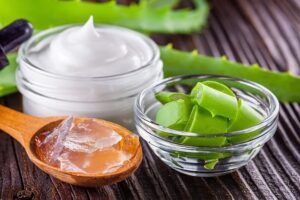
- On the other hand, avocado is sometimes called a “superfruit” for hair. It contains oleic acid and monounsaturated fats, both of which are easily absorbed by hair fibers. Because avocado oil is lighter than shea butter, it is perfect for people with fine to medium hair who nevertheless need deep nourishment without feeling heavy. Vitamin C, biotin, and folate are also abundant in avocados, and these nutrients support stronger, glossier, and more resilient hair.
- According to study in the International Journal of Trichology, lipid-rich treatments like avocado oil and shea butter assist restore the lipid layer of hair, reducing water loss and promoting suppleness. By strengthening hair’s natural barrier, these emollients make hair softer, smoother, and more break-resistant.
- Leave-In Cream for Dry, Frizzy Hair
- Using avocado or shea butter as a leave-in cream is one of the best hair care applications. Leave-ins offer continuous hydration all day long, in contrast to rinse-out masks or oils.
- Make Your Own Leave-In Cream:
- Two teaspoons of softened shea butter
- One tablespoon of avocado oil (or, if desired, mashed ripe avocado)
- One teaspoon of aloe vera gel (for hydration that is lightweight)
- A few drops of essential oil of lavender or rosemary (optional, for scent and scalp health)
- Approach:
- Shea butter should be melted and then whipped until frothy.
- Mix in aloe vera gel and avocado oil until smooth.
- Apply a tiny bit to wet hair, paying particular attention to the ends and mid-lengths.
- Don’t rinse; continue styling normally.
- Since persons with coarse, curly, or high-porosity hair lose moisture more quickly, professional stylists frequently suggest emollient-based solutions. While avocado oil’s lightweight nature makes it suitable for most hair types, shea butter is the preferred choice for frizzy and coily hair.
- Although these natural moisturizers are generally harmless, dermatologists recommend a patch test for those who are allergic to nuts (in the case of shea butter). By using unprocessed, pure versions, chemical additives are avoided and optimal nutritional retention is guaranteed.
- A reliable, all-natural remedy for sustained hydration is offered by shea butter and avocado, which combine traditional knowledge with scientific support. They turn dry, frizzy hair into soft, moisturized, and robust hair, whether applied as a weekly routine or as a leave-in cream.
6. Rinse with Rice Water
- Amino Acids That Strengthen Hair Cuticles
- For generations, Asian beauty practices have involved the usage of rice water, particularly by the Yao women of Huangluo, China, who are renowned for having incredibly long, robust, and glossy hair.
- This age-old method is now validated by modern research, which also explains why rice water works so well to thicken hair.
- Amino acids, the building blocks of protein, are abundant in rice water and are crucial for strengthening and mending hair cuticles.
- Each strand of hair is surrounded by protective cuticles, and when they are compromised, hair becomes brittle, harsh, and more likely to break.
- Rice water’s amino acids improve elasticity and lessen split ends by strengthening and smoothing the cuticle layer.
7. Balance Diet for Stronger Hair
- Essential Nutrients: Protein, Iron, Omega-3, Vitamins
- Your food and nutrition have a significant impact on the health of your hair, so it’s not just about what you put on the outside. Since keratin, a form of protein, makes up the majority of hair, a diet high in protein serves as the basis for robust, durable hair. Insufficient protein slows down hair growth and makes hair strands weaker and more brittle.
- Another essential nutrient is iron. Iron supports growth and repair by delivering oxygen to the hair follicles. Low iron levels are a major contributor to excessive shedding and hair thinning, and they are particularly prevalent in women.
- Fish, seeds, and nuts are good sources of omega-3 fatty acids, which naturally lubricate hair follicles. They promote the growth of healthy, glossy hair, nourish the scalp, and lessen irritation.
- Vitamins also play a vital role:
- Vitamin A keeps hair hydrated by promoting the production of sebum.
- Vitamin C improves the absorption of iron and increases the formation of collagen.
- Antioxidant protection against oxidative stress, which damages hair, is provided by vitamin E.
- Dormant follicles have been shown to be stimulated by vitamin D.
- Vitamins in the B-complex, including biotin and B12, support hair growth and reinforce its structure.
- Foods to Eat Daily for Hair Resilience
- The strength and texture of your hair can be significantly improved by include particular foods in your regular diet. Here are a few nutrient-dense choices:
- Protein Sources: The keratin-building blocks your hair requires are found in eggs, lean chicken, lentils, beans, and Greek yogurt.
- Iron-Rich Foods: Red meat, pumpkin seeds, spinach, kale, and fortified cereals all contribute to healthy roots.
- Omega-3s: Walnuts, flaxseeds, chia seeds, and fatty fish (salmon, mackerel, and sardines) improve the health of the scalp and hair follicles.
- Vitamin C Sources: Broccoli, bell peppers, strawberries, and citrus foods assist your body absorb iron and produce collagen.
- Vitamin E Foods: Avocados, almonds, and sunflower seeds guard against oxidative damage.
- Foods High in Biotin: Sweet potatoes, peanuts, eggs, and mushrooms all improve the durability and thickness of hair.
8. Avoid Heat & Harsh Chemicals
- The Reasons Why Styling Tools Break
- Although curling wands, flat irons, and blow dryers produce instant styles, they have a drawback: heat damage. Overheating damages keratin proteins, weakens the cuticle, and depletes the hair’s natural moisture. This eventually causes breaking, broken ends, and dryness.
- Research published in the Journal of Cosmetic Science demonstrates that the hair shaft undergoes structural alterations at temperatures higher than 150 to 200°C. The cortex (inner layer) becomes exposed when the cuticle (outer layer) rises and breaks. Damage to the cortex causes hair to become brittle and lose its suppleness.
- The natural links in hair are also broken down by severe chemical treatments like coloring, bleaching, relaxing, or perming, which change the texture or color of the hair. Strands become weaker and lose natural oils as a result, increasing the likelihood that they will break.
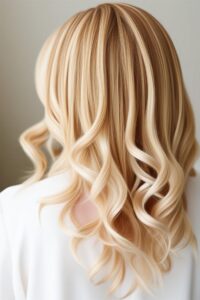
- Natural Alternatives for Styling and Shine
- The good news is that style doesn’t have to come at the expense of healthy hair. Natural substitutes offer secure methods for achieving shine, volume, and smoothness without the use of harsh chemicals or heat.
- Using styling aids and air drying Allow your hair to air dry naturally rather than using a blow dryer. To define curls and waves, use flaxseed gel, aloe vera, or lightweight gels. Overnight braiding of damp hair creates natural waves without the use of heat.
- Herbal Rinses for Shine Shine and power are added with a rosemary or green tea rinse. Rinsing with lemon water improves natural shine and helps remove buildup.
- Styles Based on Oil Almond, jojoba, or argan oils can enhance natural shine, smooth flyaways, and control frizz. Applying a few drops to wet hair creates a natural leave-in serum.
- The good news is that style doesn’t have to come at the expense of healthy hair. Natural substitutes offer secure methods for achieving shine, volume, and smoothness without the use of harsh chemicals or heat.
- Using styling aids and air drying Allow your hair to air dry naturally rather than using a blow dryer. To define curls and waves, use flaxseed gel, aloe vera, or lightweight gels. Overnight braiding of damp hair creates natural waves without the use of heat.
- Herbal Rinses for Shine Shine and power are added with a rosemary or green tea rinse. Rinsing with lemon water improves natural shine and helps remove buildup.
- Styles Based on Oil Almond, jojoba, or argan oils can enhance natural shine, smooth flyaways, and control frizz. Applying a few drops to wet hair creates a natural leave-in serum.
- Tools for Heat-Free Styling Without using heat, cloth hair curlers or Velcro rollers produce volume and curls. Shine is enhanced by the uniform distribution of natural oils using wooden combs and brushes.
- Do-it-yourself Shine Sprays In a spray bottle, combine aloe vera, rose water, and a few drops of essential oil. For immediate, chemical-free smoothness and aroma, lightly mist.
- Dermatologists recommend using a heat protectant spray and keeping the temperature below 150°C to reduce damage if heat styling cannot be avoided. They advise using deep-conditioning masks after chemical treatments and separating sessions by several months.
- Experts also stress that while natural alternatives might not provide salon-quality results right away, they do provide resilience and long-term protection. A balance between look and health can be achieved for people who style their hair frequently by switching between natural and heat procedures.
- You may guarantee stronger, healthier hair strands in the future by protecting your hair’s cuticle, retaining moisture, and maintaining its natural shine by avoiding harsh chemicals and high heat and substituting them with mild, natural alternatives.
9. Gentle Hair Care Habits
- Hair breakage is frequently caused by daily routines rather than products. Your hair can be protected or subjected to needless stress and breakage depending on how you brush, detangle, and handle it.
- The most frequent error is vigorously brushing wet hair. Wet hair is weakest because it swells with water and is more likely to break and stretch. Trichologists claim that pulling on damp knots results in tiny tears along the cuticle, which ultimately create split ends.
- The right approach is to:
- To loosen big knots, start by gently detangling them with your fingers.
- Work your way slowly up toward the roots from the ends. This lessens the strain on the scalp and stops violent pulling.
- To make knots simpler to work through, apply a detangling spray or a few drops of oil to damp hair.
- Keep in mind that too many brush strokes might remove natural oils and weaken the cuticle.
- Dermatologists emphasize that brushing should be about dispersing natural oils and preserving smoothness rather than causing constant friction. In the long run, gentle handling keeps hair appearing healthier, preserving its flexibility and preventing breakage.
- Choosing Natural Shampoos & Wide-Tooth Combs
- It also matters what items and tools you utilize. Although harsh shampoos including sulfates, parabens, and silicones may initially leave hair feeling immaculate, they can deplete natural oils, alter the pH of the scalp, and gradually weaken cuticles.
- Making the switch to natural or gentle shampoos that contain plant extracts (such as green tea, hibiscus, neem, or aloe vera) will keep your scalp hydrated and nourished. Formulas without sulfates gently cleanse your hair without weakening its protective layer. Sulfate-free shampoos are often suggested by dermatologists for people with dry, frizzy, or chemically damaged hair.
- Experts in hair care frequently stress that prevention is preferable to treatment. Long-term damage can be considerably decreased by forming tiny, benign habits. For instance, sleeping on a satin pillowcase minimizes friction and tangles, and tying hair loosely rather than with tight elastics decreases breakage caused by stress.
- Trichologists and dermatologists concur that regular, conscientious habits are just as important to hair health as treatments. Wide-tooth combs, natural shampoos, and meticulous detangling are easy yet scientifically proven methods to keep your hair healthy.
- In summary, gentle hair care practices may not seem like much, but they are the cornerstone of robust, naturally strong hair that doesn’t break.
10. Apply Onion Juice for Strength
- Although it may not sound glamorous, one of the most natural ways to strengthen and fortify hair is to use onion juice. The secret is its high sulfur content, a mineral that is essential for the synthesis of collagen and keratin, the proteins that give hair its robust structure.
- Because it fortifies the keratin connections, sulfur is frequently referred to as the “beauty mineral,” which reduces the likelihood of hair breaking. It increases elasticity and makes hair more resilient to environmental stressors, pollutants, and styling by increasing the production of collagen.
- Applying onion juice can greatly enhance hair regrowth in cases of alopecia areata, a disorder that causes bald patches and hair thinning, according to a number of studies, including one that was published in the Journal of Dermatology.
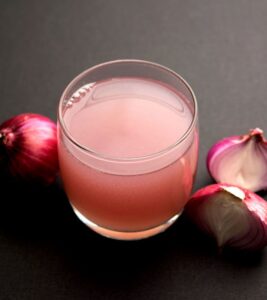
- Sulfur Compounds That Boost Collagen Production
- Although it may not sound glamorous, one of the most natural ways to strengthen and fortify hair is to use onion juice. The secret is its high sulfur content, a mineral that is essential for the synthesis of collagen and keratin, the proteins that give hair its robust structure.
- Because it fortifies the keratin connections, sulfur is frequently referred to as the “beauty mineral,” which reduces the likelihood of hair breaking. It increases elasticity and makes hair more resilient to environmental stressors, pollutants, and styling by increasing the production of collagen.
- Applying onion juice can greatly enhance hair regrowth in cases of alopecia areata, a disorder that causes bald patches and hair thinning, according to a number of studies, including one that was published in the Journal of Dermatology.
- How to Use Onion Juice Safely for Reducing Breakage
- Despite its potency, onion juice needs to be utilized properly to prevent irritation or pain. This is a safe technique that dermatologists recommend:
- Components:
- One medium onion
- One tablespoon of carrier oil (optional for dilution; such as coconut or olive oil)
- Approach:
- After chopping and peeling the onion, mix it into a paste.
- To extract the juice, strain the paste with a muslin cloth.
- Using your fingertips or a cotton ball, apply the juice straight to your scalp.
- For five minutes, massage lightly to increase circulation.
- Just leave it on for 20 to 30 minutes.
- To get rid of the smell, rinse well with a gentle shampoo.
